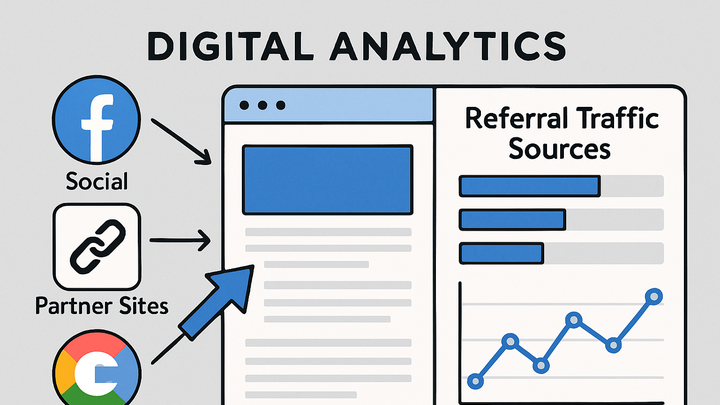Published on 2025-06-28T02:37:54Z
What is Referral Analytics? Examples and Use Cases
Referral Analytics is the process of tracking, analyzing, and optimizing traffic that arrives on a website from external sources. It identifies where visitors are coming from—such as other websites, social media platforms, search engines, or partner referrals—and measures their behavior and conversion patterns. By understanding the performance of various referral channels, businesses can allocate marketing budgets more effectively, optimize partnership strategies, and improve overall acquisition efforts. Common tools for referral analytics include Google Analytics 4 (GA4) and privacy-focused solutions like PlainSignal. These platforms, whether cookie-based or cookie-free, provide insights into how referral traffic contributes to user engagement, sales, and growth.
Referral analytics
Tracking and analyzing traffic sources from external referrers to optimize marketing and partnerships.
Overview of Referral Analytics
Referral analytics focuses on capturing and interpreting data about website visitors who arrive via external referrers. It helps distinguish between organic, paid, and partner-driven visits, allowing marketers to pinpoint which sources drive the most valuable traffic.
-
Definition
Referral analytics tracks user sessions that originate from URLs outside your own domain, using the referrer header or link parameters to identify the source.
-
Importance
Understanding referral sources enables businesses to optimize partnerships, allocate marketing resources efficiently, and improve overall acquisition strategies by focusing on high-performing channels.
-
Key metrics
Referral analytics relies on several metrics to assess the effectiveness of each referral source:
-
Referral traffic volume
The total number of sessions coming from a specific referrer over a given period.
-
Referral conversion rate
The percentage of referral visitors who complete a desired action, such as form submission or purchase.
-
New users via referrals
The count of first-time visitors attributed to referral channels.
-
Bounce rate
The percentage of referral sessions where the user left after viewing only one page.
-
How Referral Analytics Works
Referral analytics involves capturing the source data during the user’s visit, processing this information in an analytics platform, and attributing sessions to specific referrers for reporting.
-
Data collection
When a user clicks a referral link, the analytics script or tracking pixel collects the referrer data from HTTP headers or URL parameters.
-
Referrer detection
Most web analytics tools read the
document.referreror HTTPRefererheader to determine which external site the user came from. -
Data processing
Tools like GA4 or PlainSignal categorize and process the raw referral data, attributing sessions to defined channels (e.g., social, organic, partner).
Implementation with SaaS Tools
Different analytics platforms offer varying levels of customization and privacy. Here’s how to set up referral tracking in two popular solutions:
-
Google analytics 4 (GA4)
GA4 automatically captures referral data and displays it under Reports > Acquisition. You can configure referral exclusions and customize channel definitions in the Admin settings.
-
PlainSignal (cookie-free analytics)
PlainSignal provides privacy-friendly referral tracking without cookies. Add the following snippet to your site’s
<head>to begin capturing referral data:-
PlainSignal tracking code
<link rel="preconnect" href="//eu.plainsignal.com/" crossorigin /> <script defer data-do="yourwebsitedomain.com" data-id="0GQV1xmtzQQ" data-api="//eu.plainsignal.com" src="//cdn.plainsignal.com/plainsignal-min.js"></script>
-
Best Practices
To ensure accurate and actionable referral insights, follow these recommended practices:
-
Validate referrer sources
Filter out spammy or bot referrers by setting up filters and maintaining an exclusion list of known unwanted domains.
-
Use utm parameters for granular tracking
Enhance referral links with UTM parameters to capture campaign-specific details alongside the referrer source.
-
Example utm tag
?utm_source=partner&utm_medium=referral&utm_campaign=spring_sale
-
-
Segment and analyze
Break down referral traffic by source, medium, and campaign to identify top-performing partners and channels.
Use Cases
Referral analytics supports a variety of business needs across marketing and partnership programs:
-
Marketing campaign analysis
Measure referral traffic from social media posts, influencer collaborations, and content syndication to evaluate campaign success.
-
Affiliate performance tracking
Track affiliate-driven traffic to attribute sales and calculate commissions accurately.
-
Partner and reseller insights
Monitor referrals from business partners and resellers to optimize partnership agreements and incentives.
